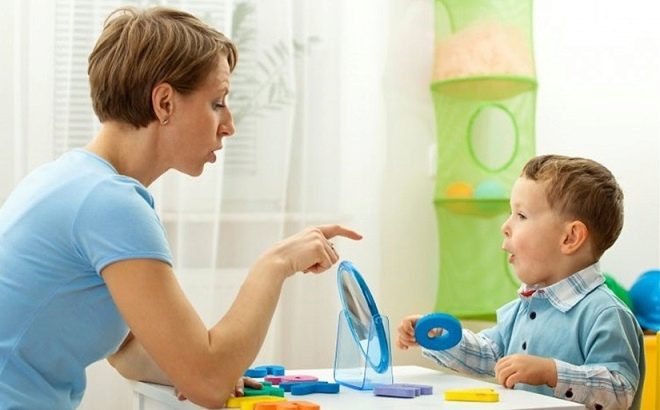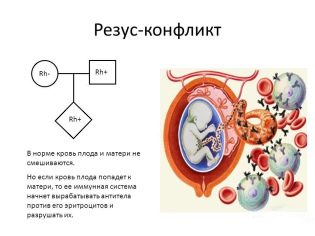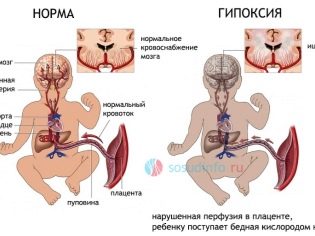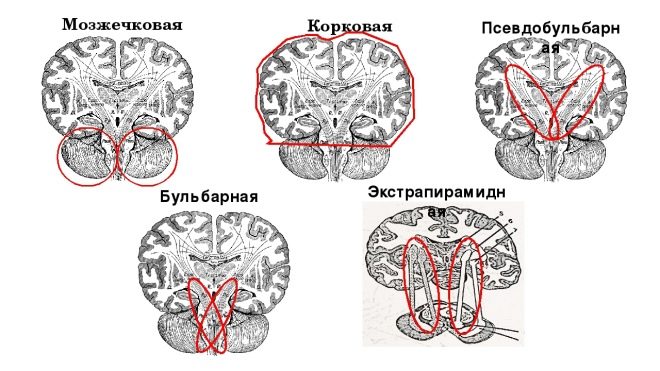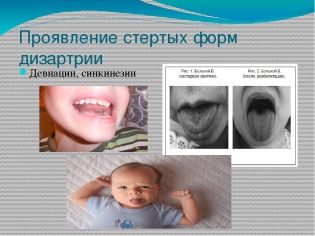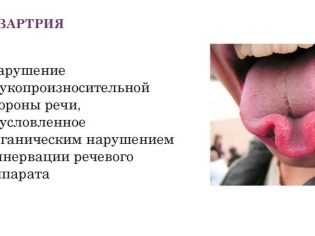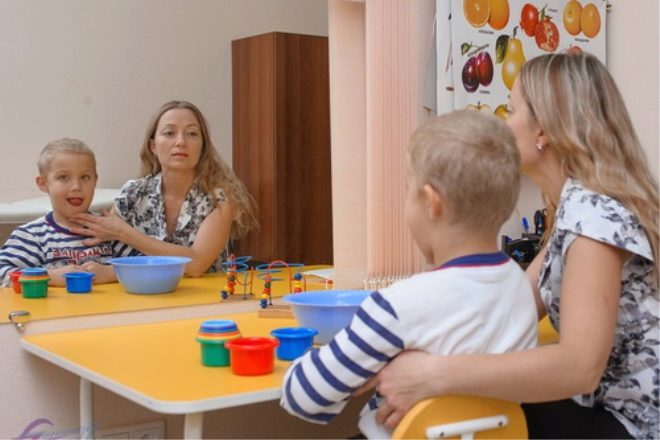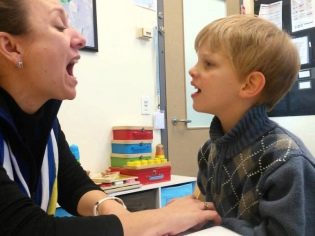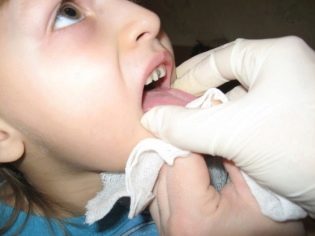What is dysarthria in children and how to treat it?
Speech disorders in children can be different. They manifest themselves in different ways, are caused by different reasons and can have different consequences. One of the severe speech disorders is pediatric dysarthria.
What it is?
The name of the pathology comes from two Greek words, which in the phrase means literally the following: “difficulty of connection”. Dysarthria occurs in violation of the nerve functions of the speech apparatus and its connection through impulses to the cerebral cortex. Innervation is impaired due to the unstable work of the nervous system. The ability to mobility of speech organs is limited. The tongue, the soft palate, the lips become weakly mobile in the baby, the articulation process is disturbed.
The muscular tissue of the speech apparatus cannot be adequately reduced, which becomes a prerequisite for a violation of the pronunciation of both individual sounds and whole words. Speech breathing is impaired, speech becomes unintelligible, and if the damage to the nervous system is severe, then a complete lack of speech can develop - anarthria.
Disorder, according to statistics, affects up to 6% of children, but over the past 5 years there has been a rapid increase in the prevalence of pathology. The problem is being studied not only by speech therapists, but also by neurologists and children's psychiatrists.
Why does it occur?
Innervation of the speech motor nerves usually occurs due to more serious "failures" in the central nervous system. In 70-80% of cases, this speech disorder accompanies such a pathology as cerebral palsy. Cerebral palsy and impaired ability to pronounce clearly the sounds of speech have common causes, common origins and prerequisites. The work of the central nervous system is disrupted even in utero, either in labor or in the first hours or days after birth. Brain lesions are usually organic, associated with birth injuries, fetal hypoxia.
Experts see a close relationship between the nature of the pregnancy in the mother and the possible development of dysarthria in the child. So, for women who suffered during a baby’s waiting period with strong toxicosis, for those with fetal hypoxia, Rh-conflict between the mother and the child, the likelihood of speech disorders is higher in the child. Organic hypoxia during childbirth and the development of severe nuclear jaundice after birth and premature birth of the child can cause organic brain damage, depending on the period in which they appeared, CNS damage is a common phenomenon.
The earlier the birth, the higher the likelihood of such consequences. The harder the motor abilities of the child are impaired, the more pronounced is dysarthria.
All of the above does not mean that the pathology is not able to develop in boys and girls who were born healthy and not burdened with diagnoses such as cerebral palsy. And at the age of 2 years, and at 4 years, and at 5 years and at any other age, children may experience innervation of the vocal apparatus as a complication after suffering severe encephalitis, meningitis, purulent otitis media. Pathology often develops with hydrocephalus, after a child has received a cranial trauma, and also as a consequence of brain damage after severe poisoning.
A brain tumor, oligophrenia, and operations on the brain can cause disruption of the speech motor nerves.But most often the pathology is not an independent disease and only acts as a symptom of a certain disease.
Types and degrees
Since dysarthria has impaired the functioning of certain nerve endings coordinating the activity of the speech muscles with the brain, then, depending on the location of the center of innervation, several types of pathology are distinguished:
- bulbar form - occurs when the nuclei of the cranial nerves are destroyed, the structure of the nerves of the glossopharyngeal nerve, the hypoglossal, vagus nerve, and sometimes the trigeminal nerve is disturbed;
- false bulbar form (pseudobulbar) - the nerve nuclei are whole, but the pathways between the cortical layer and the nuclear layer are affected;
- subcortical form - it is also called extrapyramidal, with such a pathology, speech is impaired due to the defeat of subcortical nuclei;
- cerebellar form - the name speaks for itself: the lesion is concentrated in the cerebellum;
- cortical form - impaired speech occurs against the background of several lesions of the cerebral cortex.
There is always a definite syndrome in the violation: either the muscles are overly tense, or pathologically relaxed, so experts distinguish spastic, rigid, hyperkinetic, atactic pathology.
In speech therapy, there are severity of such a speech disorder.
- First degree (it is light, it is also erased dysarthria). Outwardly, it practically does not manifest itself, and only an expert can only pay attention to problems with speech articulatory motor skills in children and only during special examinations.
- Second degree The speech is quite understandable, and children do not have serious problems with communications, but others notice some deviations, disturbances in the sound pronunciation.
- Third degree What exactly the child says can be understood only by his relatives and relatives, who spend a lot of time with him and know what exactly the child has in mind. Sometimes a part of speech is understandable and completely alien to people.
- Fourth degree (she is heavy). The absence of speech in general or its complete illegibility, in which even relatives are at a loss to explain what the child said and what he had in mind.
Symptoms and manifestations
A child with dysarthria says, and others have the impression that he “got a mess in his mouth”. His words are illegible, pronunciation is unclear, incomprehensible. Violation of the muscular component of the speech apparatus does not provide clarity and intelligibility in pronunciation. At the same time, the child also displays additional signs of a violation of the state of speech nerve endings.
Muscles may well be relaxed or overly stressed, the child often gives the impression of tension in general, because the tongue is rarely strained and remains relaxed, for example, the neck or lips. Therefore, in spastic form, the clamps extend to the muscles of the neck, the child’s lips tightly closed, the facial muscles are strained.
If the pathology develops due to excessive relaxation of the organs of speech, then the baby’s tongue is sedentary, it lies at the bottom of the mouth, the mouth is almost always half-open, the chin hangs slightly, salivation may occur, the appearance in children with such hypotension is quite characteristic. If the condition of the soft palate is disturbed, the children begin to say "in the nose."
If dysarthria is hidden, the child violates the pronunciation of only certain sounds, there is a feeling of a certain "blurring" of speech. As the degree of pathology increases, there are skips of sounds, syllables, replacing them with others. Children with dysarthria of almost any type speak slowly, there is no expressiveness, emotional coloring of speech. The activity of speech in children is reduced, there is a general underdevelopment of speech. If general paralysis occurs, motor speech function becomes impossible in principle.
Among the many violations of children's speech dysarthria has its own specifics: the violations are persistent, they are very difficult to overcome. If the child does not pronounce a certain sound, it is not dysarthria. In true dysarthria, almost the entire alphabet is not spoken, even the pronunciation of such simple vowel sounds in the reproduction is distorted.
Hissing child will try to pronounce in a lateral way, rejecting the tongue sideways, firm consonant sounds will sound more resonant and soft. Speech breathing becomes pathological: exhalation is shortened, and at the moment when something needs to be said, the child begins to breathe more frequently and intermittently.
The voice in children with dysarthria is quiet, weak, deaf, monotonous, gradually subsiding during the pronunciation, descending. The consequences of dysarthria in the absence of therapy may be barely visible: a person ceases to differentiate sounds normally by ear, gradually loses communication skills, he does not add up and vocabulary is not enriched.
Different types of pathology may have several different manifestations.
- Bulbar - there is no pronounced mimicry, the sucking reflex is disturbed in the infant, with great difficulty the child can swallow food, chew, he is given an excessive amount of saliva, salivation can be observed. In this form, all consonants of speech disorder sound like a single slit vague sound, the voice function is impaired - there is hoarseness, the child makes sounds “in the nose”.
- Pseudobulbar - the muscles, on the contrary, are in an increased tone, do not relax, and this is what makes the pronunciation difficult. If you ask the child to lift the tip of the tongue up and move them in different directions, it will hardly work for him. Such children are also peculiar to increased drooling, they often swallow, sometimes there is a feeling that these swallows are of a nervous nature.
- Subcortical form diseases accompanied by involuntary muscle movements, contractions, suffer not only speech, but also facial muscles. Such signs may also appear at rest, but most often they occur at times when children are worried, and the stronger the excitement, the more difficult the articulation is. The strength of the voice is broken, the timbre also leaves much to be desired. Sometimes in children with this form of dysarthria, involuntary, random guttural cries are observed. The speech itself can be either slow or fast, often the form of a disturbance is accompanied by organic stuttering.
- Cerebellar form dysarthria manifests itself in impaired speech coordination, the tongue can shake a little, the pronunciation can be “jolted” with shouts. The overall rate is reduced. But speech impairment in such a pathology is not the only sign. A child with a dysfunction of the cerebellum is unstable and unsteady gait, impaired balance, his movements are very awkward.
- Cortical form pathology manifests itself in violation of arbitrary pronunciation, loss of previously acquired speech skills. At the same time speech breathing is saved, voice and timbre are in order. The extent to which the cerebral cortex is affected depends on whether a child can not only make sounds, sometimes there are difficulties with speech recognition, writing and reading.
Diagnostics
A doctor who will lead a small patient with such a problem is a pediatric neurologist. Also, the child will attend a speech therapist. But first a correct diagnosis must be established. Neurologist will prescribe the passage of electroencephalography, electroneurography, may be performed MRI of the brain. Speech therapists have separate examination schemes. They examine the child separately and constitute the clinical and psychological characteristics.
Evaluated speech and a collection of nonverbal violations. The specialist assesses how well the speech muscles work, whether they are sufficiently active, whether there are any anatomical disturbances in their structure.Speech therapist is interested in the type of family education, the timing and nature of the child's acquisition of the first speech skills.
Treatment and Correction
Treatment is prescribed jointly by a neurologist and a speech therapist. The first may recommend medications and physical procedures to restore the functions of the nervous system. It is possible to restore them completely only in the case of mild dysarthria, with organic brain lesions only a partial correction of the disorder is available.
To visit a speech therapist will often and regularly. He will give recommendations to parents for classes with the child at home, and will also conduct classes with the baby on his own.
There is no universal way or scheme to cure dysarthria. An individual adapted rehabilitation and correction program is developed for each child.
The child must be acupressure, exercise therapy, it is possible the appointment of therapeutic baths, acupuncture. Good alternatives such as dolphin therapy, ipotherapy, and art therapy, especially those sections that imply the development of fine motor skills such as sand training, modeling, and quilling, show good results as a baseline for correction.
Finger gymnastics will help to treat speech impairment to a greater extent than it may seem at first glance - the better a child with normal psychophysical development has his fingers, the better the muscles of his speech apparatus develop.
Speech therapist will teach parents to conduct speech therapy massage and do articulation gymnastics with the baby, special attention will have to be paid to the development of speech breathing. Different complexes will be given for younger or middle age using sound pronunciation technology.
Separately, it is recommended to conduct classes on the development of emotionality, including speech. For this, experts recommend the child contact with animals.
The treatment process is very long, painstaking, requiring patience, diligence and commitment from parents. Forecasts will depend not only on the initial degree of pathology, but also on how much moms and dads can be consistent and hardworking in correcting dysarthria. Favorable results can be achieved only when the correction has begun early. When running dysarthria, the predictions are much worse. Much depends on the prediction and on what the underlying disease is.
It is almost completely possible to correct the speech only in the case of latent dysarthria, and then provided that the parents are diligent. Such children will be able to study in a comprehensive school without any problems. In other cases, it is not possible to fully recover, but only to improve speech skills and functions. For better adaptation in society, such children are recommended to attend specialized kindergartens and educational institutions for pupils and pupils with speech disorders. A systematic visit to a speech therapist, neurologist, and neuropsychiatrist is also recommended.
It is possible to prevent dysarthria, if the child was born with a birth injury, ahead of time, with neurology or organic brain lesions, but such preventive work should be carried out from the very first days of the infant's life. It consists in preventing neuroinfections (meningitis, encephalitis), etc. at any cost.
Reviews
On the Internet, parents of children with an established diagnosis of “dysarthria” usually meet and communicate within groups, because the treatment is long, takes many years, during which time mothers have time to get to know each other well.
Messages from moms indicate that there is no miraculous cure, any, even the smallest progress in the state of the child, the result of long and painstaking work of parents, doctors, speech therapist, massage therapist, chiropractor.
Experienced parents urge to start treatment as early as possible so that the results of the correction are noticeable to school.Schoolchildren with such a problem, according to reviews of moms and dads, learn worse, it is difficult for them to memorize the curriculum, they write with a lot of mistakes. Speech therapists also take care of dysgraphic treatment, but, according to moms and dads, in small towns it is quite difficult to find specialists who would take up remedial work with children 2 or 3 years old. Typically, speech therapists before 3-4 years of classes do not start, sending parents to look for another specialist - a pathologist. In small towns, there may be big problems with the availability of such specialists.
For what dysarthria is, how to recognize and treat it, see the next video.

